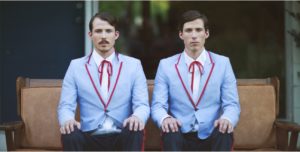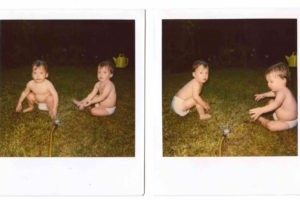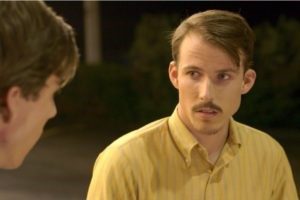A Filmmaker, His Twinship, and His Twinsburg Experience
I attended the Twins Day Festival as a researcher in August 2014. At that time I had the pleasure of meeting Phil and Joe Garrity. They arrived at the festival with a small crew to help them shoot footage for the film that Joe had envisioned. The short film Twinsburg is terrific. I am planning to show it at my Omega Institute workshop on twin relationships, July 28–30. Joe has kindly offered to come to speak about his emotional journey through the process of writing, producing, and starring in the film with his brother.
Joe wrote an article about his experience making the film, and he has given me permission to share his story with my readers. I think you will find his insights and thoughts about his twin experience poignant and heartfelt.
The article originally appeared in the Independent on September 18, 2016. It is reprinted with permission.
Expanding Off-Screen Relationships, On Screen: A Closer Look at “Twinsburg”
As filmmaker Joe Garrity looks to take his story from a short to something bigger, he looks back on the at-times symbiotic relationship between his film and his “twinship”—and what that means for its expansion.

Joe Garrity and his twin brother, Phil, star in “Twinsburg.”
Earlier this year, independent filmmaker Joe Garrity debuted Twinsburg, a short film about identical twin brothers, Jerry and Paul, who reconnect at the largest gathering of twins in a small town in Ohio. In this essay, Garrity chronicles the making of the story and its impact on his relationship with his own twin, who he played opposite in the film—as well as how he plans to expand it from a short into something greater.
Myth and truth are identical.
That means they once were one, but now they are two. Most people have a hard time telling them apart at first, but once you get to know them they’re practically unmistakable. Some people are hopeless and will never know the difference.
We’re identical too, Phil and I. I was named Joseph, because I was born first and our parents had prepared only one name at the time of our birth—the other was up for debate, but soon “Baby B” became Philip. Phil.
I used to wonder if I was actually born second, actually Baby B. What if among all the small transgressions we would endure against our individuality—all the times we would be heedlessly mistaken, measured, grouped, divided—what if one of the very first was more than just a passing mistake, but a complete and total switcheroo. A “twinversion,” as we coined it.
As far as absurd hypotheticals went—and they went far among my brother and I, born improvisers—the minutia was ultimately trivial: exactly how, and when, and what would it mean if we were technically the other? Even the short film we made exploring the premise, conceived and executed in a lightning week when Phil visited in my last year of college, failed to yield more than a passing amusement. Still my curiosity nagged. There was something in the question of our interchangeability that held a deeper meaning for me.

Joe Garrity, with his brother, Phil, from a scene in “Twinsburg.”
We used to be more alike, more in synch. They say our kind of twins—”mirror-image”—came from the same egg, fertilized by the same sperm, becoming the same zygote that around the eighth day of its union—late for non-conjoined twins—cleaved in two. They say that’s what gives me my left-handedness, and Phil his right-, and me my cowlick, and Phil his, whirling in the opposite direction, and so on. So they say.
A year after college, while living on opposite coasts, I asked Phil to meet me in a small Midwest town. I wanted to make another short film with him, an expansion of the premise we’d originally explored, this time in Twinsburg, Ohio, a town founded by identical twin brothers and home to the world’s largest annual gathering of twins: a twin convention. Phil was less than thrilled.
Working from a loose script, we roamed the parades and pageants with a mixture of amusement and apprehension. We weren’t like these twins, gleefully donning matching outfits, competing in most-alike contests, even subjecting themselves to experimental research in exchange for crisp twenty dollar bills. We were there for other reasons, as outsiders it seemed. Technically we were in the club, but in practice we were far from it. Back in the hotel room, we squabbled over the direction of the film. We parted ways with a scattering of footage, returning again to our opposite coasts. I seemed no closer to saying anything truthful about my twin identity. The words escaped me, on the page and off. I longed for a time when we hardly needed those words, when our mere shared presence was an understanding.
Phil and I called ourselves “YaYa” until we were in kindergarten. “YaYa” meant “me” and “you” and “us.” According to our mom, it was a remnant of a secret language we babbled as toddlers. I remember the day Phil insisted we leave “YaYa” behind, embarrassed by our new schoolmates’ notice, opting instead for our given names. His felt foreign to me. “Phil.” With mine, I didn’t connect. It was my first taste of the separation, the kind I would try to give name to all these years later.

Joe Garrity and his brother, Phil, as children.
In researching for the film, I came across a book called Identity and Intimacy in Twins published in 1983 by Barbara Schave and Nancy Ciriello. These researchers, separately identical twins themselves, characterized six twin identity types. There was diversity in twin relationships, they found, based primarily upon upbringing. The “idealized identity” type held a special resonance. It describes twins raised to believe they were special because they were twins. It described ones whose bond was strongly projected upon them, which in adulthood manifested as a false intimacy between them—essentially, it described twins who discovered they weren’t actually as close as they were once convinced. Finally, someone had truthfully articulated my experience of twinship. The myth of our sameness was confronted at last by the reality of our separateness.
While researching for the film brought me closer to understanding the dynamic between characters Jerry and Paul, I was no closer to resolving the growing rift between Phil and I. And like that, the story took an inward turn.
Phil got sick, struck with a rare bone cancer that threatened to separate us for good. The hospital, the original scene of the crime in the “twinversion” theory, now became a bookend for where we had begun and where we might find our end. Darker tones imbued the story as I scrambled to make sense of this horrific plot twist. It seemed through fiction—myth and truth—I had discovered a mode of grieving, exploring the dark alleys of possibility from the safety of a pen’s length. Returning to Boston month after month to watch Phil endure the hellish treatment, the story reached deeper toward a personal truth that I was growing more certain was ours alone to tell, if there was still time.
A year of chemotherapy and surgery and Phil recovered, now with a receded hairline and an inch taller than me thanks to a miscalculated knee replacement. We were becoming less recognizable to one another, in body and spirit.
Even in the wake of recovery Phil and I searched for the words to describe our pain. Phil retreated in Ireland to begin a spiritual memoir of his experience with cancer. I returned to California, to my stacks of yellow notepads still waiting to become a story—our story. Phil, however, took no interest in its development, considering the project indefinitely dormant, perhaps wishing it would never be made. Our first attempt in Twinsburg had been slapdash enough to shake his confidence that I would ever be prepared. And it was true that after countless drafts and endless revising, the story seemed to only inch toward the truth of our relationship. Maybe waiting another year, I thought, would buy myself more time to get it right.
I could spend a lifetime poring over each word in an attempt to achieve perfection, still risking final satisfaction, or I could dive in with my brother beside me and see what came of it. I dove.
Much to his chagrin, I beckoned Phil back to California three weeks before his Ireland journey was set to end, as pre-production shifted into high gear. He arrived without much patience for the demanding schedule, the last-minute story meetings, or the final preparations that sent our mostly green crew of eleven to rural Ohio for a weeklong shoot during a live convention. We were in for it.

Scene from “Twinsburg.”
Now that the project was real to him, Phil brought a slew of opinions about his character who he felt was an unfaithful reproduction of his real-life identity. “It’s not you,” I would say. “It’s two different aspects of me.” Subplots came and went and came back again. Was the switched-at-birth premise still in? The cancer reveal? Paul’s fling with Nancy? In Ohio, I was rewriting scenes in the hotel room, in the car on the way to set, even on the spot, with the cameras waiting. As a writer-director-actor suddenly entrusted with a slim budget, a mostly green crew, and an open set to oversee, I was underwater. The chain of command was broken across the production, and the one person who was there to guide it—the director, me—was out of service, trying to inhabit Jerry, a heartbroken twin and one half of me.
Another side of me was angry. A side of me was Paul, the twin who longed for freedom, distance, disentanglement. An end to the cruelty of comparison, by others and by us, too. We both wanted to be close again, but we were moving in opposite directions.
When it came time to film the scene where the brothers confronted each other head on, I channeled the loss I felt: the loss of my twin, my brother, even as he stood there beside me. “WHERE DID YOU GO?!” I burst out at him, a question that came as unexpectedly and unscripted as my tears. The intensity of my sadness and anger surprised even me. The quirky, dry comedy we had been making up until that point took a radical shift. It was visceral, real, and suddenly potent.
Production ended and we could barely speak. In the months following we tried to resolve the tension that had reached a boiling point in Ohio, but often conversations ended abruptly in argument. Editing the footage we had, I realized the ending was completely tacked on, a flimsy stand-in for what really needed to be there: some kind of resolution.
The following summer I was still working on the cut, having all but finished the first two acts of the movie, right up through the fight scene. Then there was the outro, with nothing in between. I sketched our reshoot pages, again unsure whether the material was right. It wasn’t right because it hardly included Phil’s character Paul, and it needed to. This film was about the relationship between two brothers, and I needed them both to find a resolution together.
Late one night after work, Phil came to my office. It was the day before the final reshoots were scheduled and I was still at a loss for the resolution scene. Our relationship had been through the gauntlet in the past few years, and now after a long exchange of opinions, and some dead end squabbling, we were sitting in silence—a full ten minutes of silence. This is the end, I thought: we’re out of ideas, out of words. I’m haunted by the same fear that has plagued these last four years: this film will never be finished and the full story of Twinsburg might elude me forever.
Then, Phil spoke. He did so not with words of contradiction, criticism, nor negation, but of contribution. The air was electric again. We were collaborating for what felt like the first time in a very long time. We stayed flexible, open to seeing past our own perspectives. On our way to set the next day, Phil and I continued rewriting the dialogue together, believing that even at this late hour there was still hope in articulating some kind of reconciliation, on the page and off. There was still a chance.
Despite all the attempts to plot it in advance, only through the act of performing the argument—and eventually its resolution—did I begin to understand the inner workings of my fractured twinship. There was sadness and anger there. There was grief. I was telling a story about grief, a revelation that I couldn’t have understood without facing it, head on—without diving in. In exploring this other identity through filmmaking, I became more in tune with my own. In the height of acting, we had reached the depth of our real-life issues.
With the resolution scene completed, production wrapped, and the film has since shown at festivals. I’m moving the expansion of Twinsburg from a short to feature, from my personal connection of the “idealized identity” to looking to understand the broader range of twin relationships. I look to expand on the notion of twinship to encompass the diversity I’ve come to know in twin relationships.
The journey continues. I’m still learning about my twinship, about the differences that we must accept, about the path toward reconciliation. My hope in telling the full story of Twinsburg will be to finally say all that I wanted, that I’ve needed to express for so long. It’s there in the dedication at the end of the short film: “For us.”

